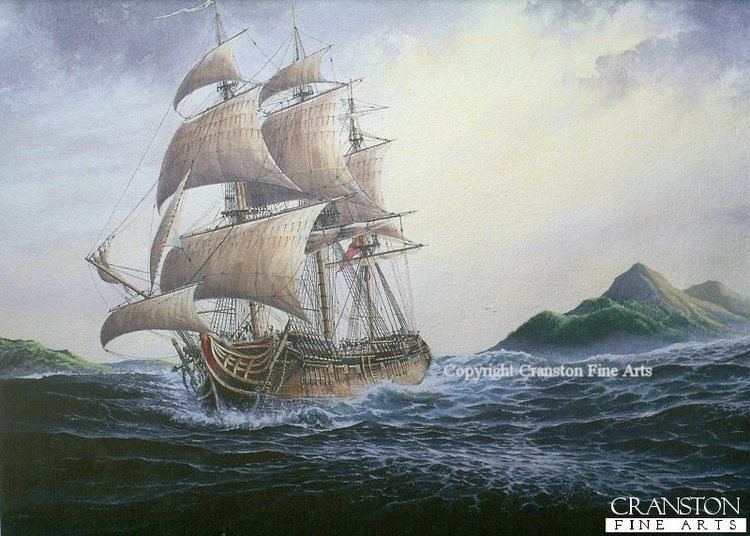Name HMS Resolution Draft 3.99 m Weight 462 tons | Length 34 m Launched 1770 Propulsion Sail | |
 November 1771 as Marquis of Granby Renamed Renamed HMS Drake in November 1771Renamed HMS Resolution on 25 December 1771 Captured By the French on 10 June 1782 | ||
HMS Resolution was a sloop of the Royal Navy, a converted merchant collier purchased by the Navy and adapted, in which Captain James Cook made his second and third voyages of exploration in the Pacific. She impressed him enough that he called her "the ship of my choice", and "the fittest for service of any I have seen."
Contents
Purchase and refitting
Resolution began her career as the North Sea collier Marquis of Granby, launched at Whitby in 1770, and purchased by the Royal Navy in 1771 for £4,151 (equivalent to £490,777.23 today). She was originally registered as HMS Drake, but fearing this would upset the Spanish, she was soon renamed Resolution, on 25 December 1771. She was fitted out at Deptford with the most advanced navigational aids of the day, including an azimuth compass made by Henry Gregory, ice anchors, and the latest apparatus for distilling fresh water from sea water. Her armament consisted of 12 6-pounder guns and 12 swivel guns. At his own expense Cook had brass door-hinges installed in the great cabin. It was originally planned that the naturalist Joseph Banks and an appropriate entourage would sail with Cook, so a heightened waist, an additional upper deck and a raised poop deck were built to suit Banks. This refit cost £10,080.12.9d. However, in sea trials the ship was found to be top-heavy, and under Admiralty instructions the offending structures were removed in a second refit at Sheerness, at a further cost of £882.3.0d. Banks subsequently refused to travel under the resulting "adverse conditions" and Johann Reinhold Forster and his son, George, replaced him.
Cook's second voyage
Resolution departed Sheerness on 21 June 1772, carrying 118 people, including 20 volunteers who had sailed on Cook's first voyage in HMS Endeavour in 1768–1771, and two years of provisions.[a] She joined HMS Adventure at Plymouth and the two ships departed English waters on 13 July 1772.
Resolution's first port of call was at Funchal in the Madeira Islands, which she reached on 1 August. Cook gave high praise to her sailing qualities in a report to the Admiralty from Funchal Roads, writing that she "steers, works, sails well and is remarkably stiff and seems to promise to be a dry and very easy ship in the sea." The ship was reprovisioned with fresh water, beef, fruit and onions, and after a further provisioning stop in the Cape Verde Islands two weeks later, set sail due south toward the Cape of Good Hope. Several of the crew had brought monkeys aboard as pets, but Cook had them thrown overboard to prevent their droppings from fouling the ship.
On his first voyage Cook had calculated longitude by the usual method of lunars but on her second voyage the Board of Longitude sent a highly qualified astronomer, William Wales, with Cook and entrusted him with a new marine chronometer, the K1, recently completed by Larcum Kendall, together with three chronometers made by John Arnold. Kendall's K1 was remarkably accurate and was to prove to be most efficient in determining longitude on board Resolution.
On 17 January 1773, Resolution was the first ship to cross the Antarctic Circle and crossed twice more on the voyage. The third crossing, on 3 February 1774, was the most southerly penetration, reaching latitude 71°10′ South at longitude 106°54′ West. Resolution thus proved Alexander Dalrymple's Terra Australis Incognita to be a myth. She returned to Britain in 1775 and was then paid off.
Cook's third voyage
She was recommissioned in February 1776 for Cook's third voyage, which began on 12 July 1776, departing from Plymouth, England, during which Resolution crossed the Arctic Circle on 17 August 1778, and again crossed it on 19 July 1779, under the command of Charles Clerke after Cook's death. She arrived back in Britain on 4 October 1780.
Later service and loss
In 1780, Resolution was converted into an armed transport and sailed for the East Indies in March 1781. Sphinx and Annibal of Suffren's (French) squadron captured Resolution on 9 June 1782. After the action at Negapatam on 6 July 1782, Resolution sailed to Manila for wood, biscuit and rigging, and to press any seaman she found there. She then sailed on 22 July 1782 and was never seen again.
On 5 June 1783 de Suffren wrote that Resolution had last been seen in the Sunda Strait, and that he suspected she had either foundered or fallen into the hands of the English. An item from the Melbourne Argus, 25 February 1879, said that she ended her days as a Portuguese coal-hulk at Rio de Janeiro, but this has never been confirmed. Viscount Galway, a Governor-General of New Zealand, owned a ship's figurehead described as that of Resolution, but a photograph of it does not agree with the figurehead depicted in Holman's famous watercolour of her.
Alternatively, in 1789 she may have been renamed Général Conway, in November 1790 Amis Réunis, and in 1792 Liberté. Martin Dugard's biography of Cook, Farther Than Any Man, published in 2001, states: "Her fate, by some cruel twist of historical irony, is as incredible as Endeavour's – she [Resolution] was sold to the French, rechristened La Liberte, and transformed into a whaler, then ended her days rotting in Newport Harbor. She settled to the bottom just a mile from Endeavour." (p. 281, Epilogue)
However, there is a report from 1881, that the British Consul in Alexandria looking from the Ras el-Tin Palace pointed out the Resolution in the harbour to William N. Armstrong who attended the Hawaiian King David Kalākaua during his trip around the world.
